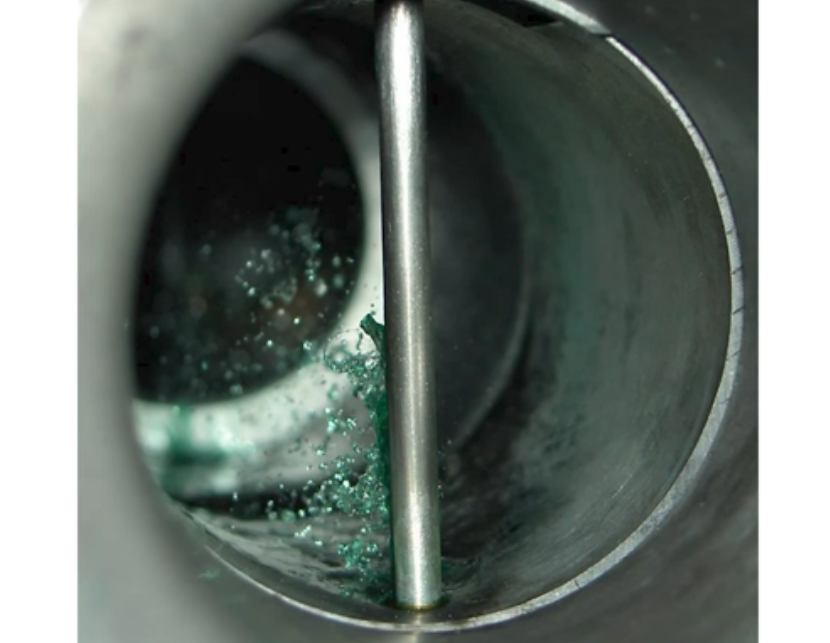 Perfect WOT Jetting I have been pursuing the idea that the best carb is that which at WOT provides a certain percentage of large fuel droplets that aid in piston/cylinder cooling and oil delivery. Most of them turn to vapor upon contact with hot metal but some don't and drool down into the crankcase to lube the bearings and then get slung back up by the rotating crank wheels. The % of large fuel droplets is determined by max air velocity, fuel flow rate, and needle to needle jet clearance. The faster the air, the more tiny fuel particles are sheared off of the large and medium sized droplets. (This isn't truly new because I'm sure that everything I discover has probably been known by the motorcycle engineers for decades.) Notice how undersized carbs are fitted to low performance engines? That gives them the perfect ratio of small+medium droplets to large droplets at a mid range RPM. To get that perfect % for a high RPM racer you need a larger carb. Fuel Droplet Sizes Vapor - for insuring the mix is ignited and the flame spreads to the randomly spaced larger droplets. This is created by the idle jet and from fuel sheared off the small fuel droplets by high velocity air in the intake tract. Small + Medium - these contain much more fuel per area as vapor and so are classified as contributing mostly to power. Large - most of these are slung out of air suspension before they reach the combustion chamber. They collide with hot metal parts to cool them and deliver oil to them, especially to the crank and rod bearings. After being slung up by the crank wheels they eventually find their way to the combustion chamber to add to power. Hot Vapor - These are created by large fuel droplets (and a little bit of the others) colliding with very hot metal parts. The fuel absorbs the heat and then the fuel vapor and its surrounding air expands which is detrimental to power because it competes for space with the air/fuel mix of the small and medium droplets. From my experience if the head is exceeding 300 degrees F (air cooled engines) then hot vapor is being produced and power is going down. Oil in fuel - What oil doesn't contact the metal parts is burned in the combustion flame so don't think of all oil in the gas as being for lubrication. This is why products with castor oil increase power, because the castor oil burns rapidly, unlike synthetic oil. The higher the % of large fuel droplets, the more oil is used for lubrication. Needle Jet Size A "needle jet" is the orifice that the needle slides up and down in at the bottom of the venturi. The Mikuni's and Dellorto's needle jets range from 2.6mm to 2.75mm, and the Keihin PWK 33 on up are all 2.9mm. Their smaller carbs have a 2.6mm jet. The diameter affects the clearance between it and the needle. For the same flow area between a 2.7mm jet and a 2.9mm jet you will see that the needle clearance is about 13% less on the 2.9mm due to having more circumference. That can be likened to a spray nozzle. The smaller the nozzle, the finer the spray. So essentially the large PWK's imitate smaller carbs. That means a 38mm carb with a 2.9mm NJ is like a 35.4mm carb with a 2.7mm NJ. What happens when a racing engine has too small a carb? The % of large fuel droplets is too small for normal cooling and so the jetting has to compensate by having a larger than optimum (for power) main jet. When the carb is the perfect size then you can jet for best peak power under load. But when the carb is undersized then you find the jet that is optimal for best peak power and then go one or two sizes larger. That was my experience with my Kawasaki KDX200. I jetted it for best power and then quickly seized it. After that I always jetted a tad rich which also meant a tad less power. So for racers this is very important info. Carb Sizing Before now people mostly thought that bigger carbs have less flow resistance and so allow more flow into the engine. But that is not 100% true for a few reasons: 1) If you go too big a size then power drops even after jetting it right. With too much cross sectional area the vacuum decreases too much to pull up enough gas. Flow resistance creates the needed vacuum to make the carb work. Vacuum is necessary. 2) The reed valve is very restrictive to flow and dwarfs anything the carb can present. 2nd biggest resistance is the air filter. 3rd is the air box. What I Think : The fuel droplets that form from the spray from the needle jet have different sizes. Lower air velocity and larger needle to needle jet clearance both contribute to the formation of more large droplets. What is important is the ratio of large fuel droplets to the small and medium ones. The large is mostly for cooling and the small/medium mostly for power. (This is probably extreme classification but it helps me to simplify.) Too little % of the large droplets and engine heat increases for less reliability and more likelihood of seizing from piston heat if the jetting isn't rich enough. Ya gotta finish the race, right? Too much % of large droplets from too large a carb and you lower the % of small/medium droplets for power but the engine doesn't get very hot and doesn't have that power loss usually associated with overheating. Engine Heat This is the bane of race engines, one of their biggest enemies. If the engine gets so hot you have to jet it richer than what is optimum for power then you need a bigger carb. If your carb is too big then engine heat is not a problem but your power output could be better so go to a smaller carb. So the balance is between heat and power. What increases an engines heat? 1) too advanced ignition, 2) high engine compression, 3) high RPM, 4) a strong dynamic compression increase from a short and steeply angled pipe baffle cone, 5) too much pipe back pressure due to a too narrow stinger pipe or restrictive silencer, 6) too low fuel octane, 7) too hot a spark plug. Small Carbs and Mileage: Why does a smaller carb give better gas mileage than a larger carb if the engine pulls in the same mixture volume? The carbs aren't too wildly different in size for the smaller one to be considered restrictive to flow. In the following hypothetical example all the carb dimensions are proportionate to the carb bore. And the intake tract for both carbs has the same inner diameter as the carb size. That way at WOT there's no "step" for the air to deal with. ANSWER: A small carb has a higher % of small/medium drops and less large droplets. The large drops are good mostly for cooling/lubrication. So a small carb gives better gas mileage due to a higher % of "power droplets" but less cooling, less reliability. It causes the engine to be more power efficient. The lower limit of size is that which allows so much engine heat that hot vapor is formed which lowers power. Large Carbs And Power Why do larger carbs give more power? This is only true on racing engines and it is partly because they have more of a heat problem. A larger carb produces more large droplets which absorb heat and delivers more lubricating oil. The upper limit of size is when it produces too much large droplet %, too much cooling and lubrication. Then there is too little % of small and medium droplets for power. Fuel Atomization People talk about that when talking about carbs but I have a problem with that. That singular focus implies that the end goal of carburetion is to make all the gas turn to very fine globules, a very fine mist. That's just not its purpose. It makes fuel droplets of many different sizes and each size has its role to play. The goal is not the highest % of atomization. The largest fuel droplets are just as essential as the very small ones. They keep the engine from overheating which increases reliability, they carry oil to the crank bearings, and they keep the piston from melting. Questions: A good question would be "why don't fuel injected engines overheat and why do they make more power? Don't they make a fine mist without any large fuel droplets?" Answer: Actually they do run hotter. Look at how they need one heat range # more than normal. The hotter an engine runs, the higher a # is needed. Click here to read more. In the study Spray Characteristics of Throttle Body Fuel Injection was this statement: "Under idle conditions, exit plane measurements show a finely atomized uniform spray whose droplets are easily accelerated by the air flow, while results from the wide open throttle condition show a wider spray distribution" [of droplet sizes]. So at WOT they do make large fuel droplets, just not as much as carburetors. Evidence For The Theory Evidence and logical analysis of it leads to truth. So what is the evidence that there are large droplets that cool and carry oil down to the bearings? 1) You can look at high speed videos of needle jet spray and see different droplet sizes (and see the same in the top picture here), 2) knowing the laws of physics we can know that large droplets have more inertia and so are less able to remain in suspension in air when the air takes a radical turn. Also when the piston reverses from going up to going down then it's likely any large droplets there will stay where they are and let the piston contact them. That's the source of the burnt oil on the piston underside when the piston gets too hot. 3) if the large droplets are the ones most likely to come out of suspension then it is they who are doing most of the engine cooling by impacting the hot metal surfaces and absorbing some of their heat. When the engine is too hot then some or all of the droplets become hot vapor. Probably with a good amount of large fuel droplets being produced then some turn to vapor and some just run downward to then be slung back up by the crank wheels, 4) there are oil acceptance holes above the crank bearings to receive the streams that form of many droplets on their way down. 5) I know of someone that used a simple modification to reduce the large droplets to medium sized ones and he dyno'd his bike (RM250) and got a 10% power increase. I know this sounds like hype but if 5% large droplets are turning to hot vapor to displace good power-producing mix, and then you change that 5% large drops to power-producing drops then isn't that a 10% difference? But I don't think it's as essential to have large droplets cooling in a water cooled bike versus an air cooled one just because there is less need to help lower engine heat. It may benefit a little from extra cooling but it isn't necessary if the jetting is never allowed to be lean. How the droplets mostly benefit the water cooled engines is their transporting oil to the cylinder and bearings. That is essential in any engine. Testing The Theory I drilled a little hole in a central cylinder head fin of my air cooled 48cc, filled it with heat conductive paste, stuck a tiny thermocouple inside it, and sealed it on both sides with JBWeld. The thermocouple wires connected to my digital voltmeter (taped to my gas tank) which can also read temperature. 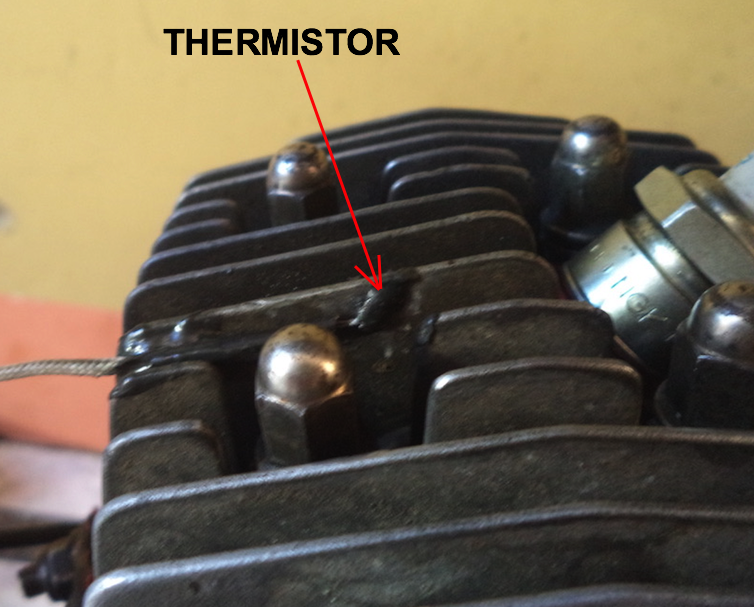 Then I did uphill runs full throttle and took note of the temp at the top of the hill. I tested two different needles for my VM18 that gave different clearances at the needle jet at WOT. 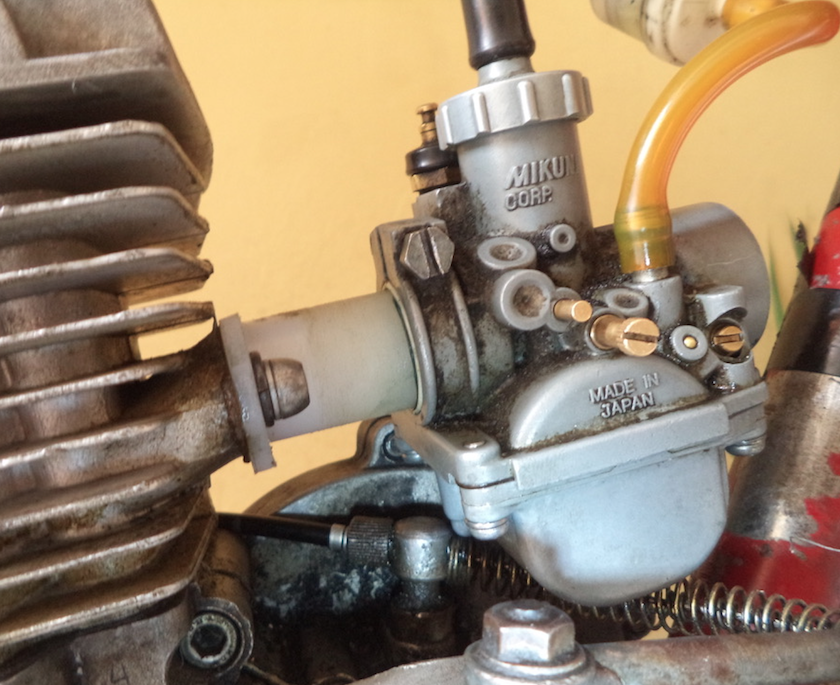 I also entered all the jetting data into my jetting calculator and took note of the total richness and the % large fuel droplets at WOT. 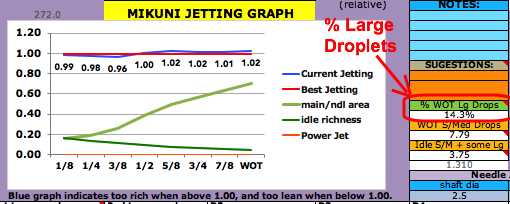 The measured temps related directly to the estimated % of large droplets, not the overall fuel amount. One needle setup provided 61% more large droplets than the other according to my calculations. The setup with more large droplets reduced the head temp by 10 degrees F on a WOT uphill run (from 312*F to 302*F). The 4F15 needle (1.5* taper) for my VM18 gave a 10.34 total WOT richness in the jetting calculator, and 20% of large droplets. On the uphill it gave 302*F head temp. The 4D8 (1* taper) needle gave a 10.46 total richness and 12.4% of large fuel droplets. It gave 312* head temp. The main jetting richness was almost identical (1.2% difference) but it was the % of large fuel droplets that differed greatly and that is what affected the engine temps. Also it was interesting how although the two setups delivered the same amount of fuel, the one with a higher % of large droplets left the piston completely clean. End result of narrow nozzle run is on the left. The residue wasn't cleaned off. Then the wide nozzle run happened and left the piston clean. 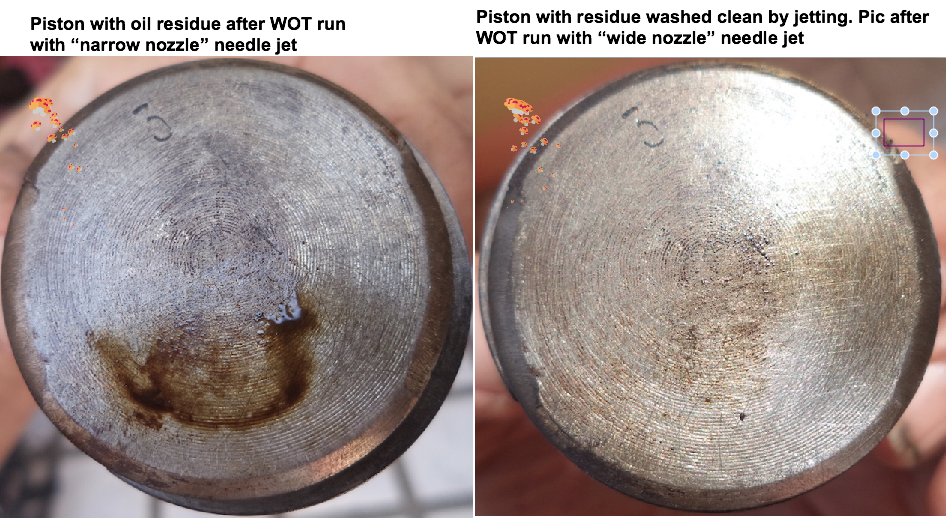 Who Needs To Make Use Of This Info? 1) people who seize engines often 2) people who ruin lower end bearings often 3) people who are tired of high engine heat causing power loss 4) people who want to extend intervals between replacement of engine parts 5) people who want their large carb to perform more like a smaller carb 6) people who want their small carb to perform more like a larger carb How Can You Utilize this Info? 1) Consult with me to find out the % of large droplets your setup produces and let me suggest a different needle and main jet to replace the old ones so you can have a higher %. I also use my oil ratio calculator to be able to make sure you are using enough oil of whatever product you are using (since it highly depends on the products viscosity). Consultation is only $10 via Paypal. my email: 19jaguar75@gmail.com 2) Get my jetting calculator (Excel spreadsheet) to enter all the data and let it show you the % of large fuel droplets for that setup. Then virtually try different needles in the calculator, noting the jetting graph and the % large drops. If a needle gives too much mid throttle richness then try lowering the needle shroud and increasing the main jet. |